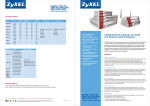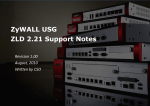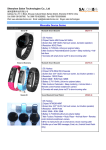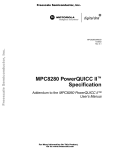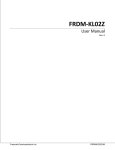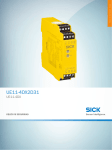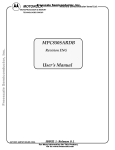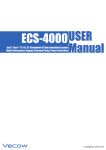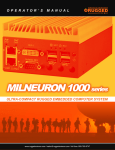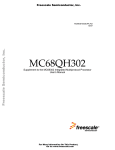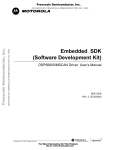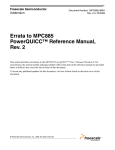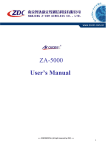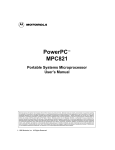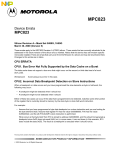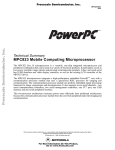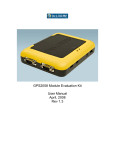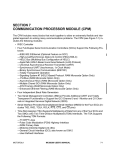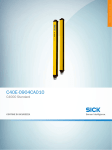Download "user manual"
Transcript
Communication Processor Module Note: This update includes documentation on the full implementation of host mode, which is available for Revision B MPC823 silicon and subsequent. Earlier revisions of the MPC823 support high speed (12 Mbs) Host Mode operation only. The universal serial bus (USB) is an industry standard extension to the PC architecture. The USB controller allows the MPC823 to exchange data with a PC host. It supports data exchanges between a host computer and a wide range of simultaneously accessible peripherals. The attached peripherals share USB bandwidth through a host scheduled token-based protocol. The USB physical interconnect is a tiered star topology. A hub is at the center of each star. Each wire segment is a point-to-point connection between the host and a hub or function or a hub connected to another hub/function. There is only one host in any USB system. The USB transfers signal and power over a four-wire cable. The signalling occurs over two wires and point-to-point segments. The USB full-speed signalling bit rate is 12Mbps. A limited capability low-speed signalling mode is also defined at 1.5Mbps. USB 16.10 UNIVERSAL SERIAL BUS CONTROLLER The MPC823 USB controller consists of a transmitter module, receiver module, and two protocol state machines. The protocol state machines control the receiver and transmitter modules. One state machine implements the function state diagram and the other implements the host state diagram. The MPC823 USB controller is capable of implementing a USB function endpoint, a USB host, or both for testing purposes (loop-back diagnostics). Figure 16-105 illustrates the USB controller block diagram. For USB implementation, it is recommended that you get a copy of the USB Specification as a supplement to this manual. You can download a copy from http://www.usb.org. 16 COMMUNICATION The USB transmitter contains four independent FIFOs, each containing 16 bytes. There is a dedicated FIFO for each of the four supported endpoints. The USB receiver has a single 16-byte FIFO. When the USB controller is not enabled in the USMOD, it consumes minimal power. MOTOROLA MPC823 USER’S MANUAL -- PRELIMINARY UPDATE -- 9.25.98 16-314 Communication Processor Module U-BUS PERIPHERAL BUS PORT CONTROL USB TX DATA FIFO TX DATA FIFO TX DATA FIFO TX DATA FIFO RX FIFO MODE REGISTER COMMAND REGISTER PORT CONFIGURATION USB FUNCTION ENDPOINT AND HOST STATE MACHINES RECEIVER ADDRESS REGISTER ENDPOINT REGISTERS TRANSMITTER DPLL/ BUS INTERFACE EXTERNAL TRANSCEIVER Figure 16-105. USB Controller Block Diagram 16.10.1 Features The following list summarizes the USB slave mode features: • Supports USB slave mode • Four independent endpoints support control, bulk, interrupt and isochronous data transfers • CRC16/CRC5 generation and checking • NRZI encoding/decoding with bit stuffing 16 • 12 or 1.5Mbps data rate COMMUNICATION PROCESSOR MODULE • Automatic retransmission upon transmit error • Flexible data buffers with multiple buffers per frame 16-315 MPC823 USER’S MANUAL -- PRELIMINARY UPDATE -- 9.25.98 MOTOROLA Communication Processor Module The following list summarizes the USB host controller features: • Supports control, bulk, interrupt, and isochronous data transfers • CRC16 generation and checking USB • NRZI encoding/decoding with bit stuffing • 12 and 1.5 Mbps data rates (automatic generation of PRE token and data rate configuration) • Flexible data buffers with multiple buffers per frame • Supports local loopback mode for diagnostics (12 Mbps only). For more details see Section 16.10.9 Using the USB Controller as a Host. 16.10.2 Host Controller Limitations The following tasks are not supported by the hardware and should be implemented by software: • CRC5 generation for token. Since CRC5 is calculated on 11 bits, this should not impose a large CPU overhead. • Retransmission after an error and error recovery. • Generation and transmission of SOF token every 1ms. • Scheduling the various transfers within frame and between frames. • The MPC823 USB host controller does not integrate the root hub. An external hub is required when more than one device is connected to the host. 16 COMMUNICATION • The host controller programming model is very similar to the function endpoint programming model and does not conform to the Open Host Controller Interface (OHCI). Although Motorola plans to support full host functionality, our implementation will not be OHCI or UHCI (Universal Host Controller Interface) compatible. Those standards define the software programming model so that software drivers can be hardware-independent. Our implementation has a much more simplified software interface. MOTOROLA MPC823 USER’S MANUAL -- PRELIMINARY UPDATE -- 9.25.98 16-316 Communication Processor Module 16.10.3 USB Controller Pin Functions and Clocking The USB controller interfaces to the USB through a differential line driver and receiver. The OE signal enables the line driver when the USB controller transmits on the bus. USB MPC823 USB TRANSCEIVER USBOE USBTXP D+ USBTXN D- + USBRXD – USBRXP USBRXN Figure 16-106. USB Interface There are six I/O port pins associated with the USB port and their functionality is described in Table 16-30. Some transceivers may need additional control lines (speed select or low-power control), which can be supported by the general-purpose output lines. 16 COMMUNICATION PROCESSOR MODULE 16-317 MPC823 USER’S MANUAL -- PRELIMINARY UPDATE -- 9.25.98 MOTOROLA Communication Processor Module PIN SYMBOL I/O FUNCTION USBTXN, USBTXP O Outputs from the USB transmitter, inputs to the differential driver. TP TN RESULT 0 0 1 1 0 1 0 1 single ended “0” logic “0” logic “1” n/a USBOE O Output Enable. Active low, enables the transceiver to transmit data on the bus. USBRXD I Receive Data. Input the USB receiver from the differential line receiver. UBRXP, USBRXN I Gated version of D+ and D-. Used to detect single-ended zero, and interconnect speed. RP RN RESULT 0 1 0 1 0 0 1 1 single ended “0” full speed low speed n/a USB Table 16-30. USB Pin Functionality The USB controller accepts a reference clock that is four times the USB bit rate. This clock is programmed in the R1CS field of the serial interface clock register (SICR) and used by the DPLL circuitry to recover the bit rate clock. Refer to Section 16.7.5.3 Serial Interface Clock Route Register for more information. 16 COMMUNICATION Note: The MPC823 can run at different frequencies, but the USB reference clock must be four times the USB bit rate. The reference clock must be 48MHz for a 12Mb full-speed transfer or 6MHz for a 1.5Mb low-speed transfer. MOTOROLA MPC823 USER’S MANUAL -- PRELIMINARY UPDATE -- 9.25.98 16-318 Communication Processor Module 16.10.4 Transmission and Reception Process USB After reset, the USB controller is addressable at the default address (0x00). During the enumeration process, the host assigns a unique address to the USB controller. The software should program the USB address register with the assigned address. The USB controller supports four independent endpoints, which can each be configured to support control, interrupt, bulk, or isochronous transfers modes when you program the USB endpoint registers. Note: You must configure endpoint 0 as a control transfer type. This endpoint is used by the USB system software as a control pipe and any additional control pipes may be provided by other endpoints. Once enabled, the USB controller looks for valid token packets. Tokens that are not valid (the PID or CRC check fails or the packet length is not 3 bytes) are ignored. RESET UNENUMERATED ENUMERATION PROCESS IDLE SETUP TOKEN SOF TOKEN IN TOKEN OUT TOKEN SETUP SOF TRANSMIT RECEIVE 16 Figure 16-107. USB Controller Operating Modes COMMUNICATION PROCESSOR MODULE 16-319 MPC823 USER’S MANUAL -- PRELIMINARY UPDATE -- 9.25.98 MOTOROLA 16.10.4.1 OUT TOKEN. When the USB controller receives an OUT token, data reception begins. The USB controller fetches the next buffer descriptor associated with the endpoint and if it is empty, it starts transferring the incoming packet to the buffer descriptor’s associated data buffer. When the data buffer has been filled, the USB controller clears the E bit in the buffer descriptor and generates an interrupt if the I bit in the buffer descriptor is set. If the incoming packet exceeds the length of the data buffer, the USB controller fetches the next buffer descriptor in the table and, if it is empty, continues transferring the rest of the packet to this buffer descriptor’s associated buffer. Otherwise, if it is full, an error occurs. The entire data packet, including the DATA0/DATA1 packet ID (PID), is written to the receive buffers and the PID is reflected in the PID field of the receive buffer descriptor. It is your responsibility to program the driver software to check data packet synchronization by monitoring the DATA0/DATA1 PID sequence toggle. USB Communication Processor Module Table 16-31. USB Out Token Reception DATA PACKET CORRUPTED USEPx RHS FIELD HANDSHAKE SENT TO HOST Yes N/A None (Data Discarded) No 00 (Normal) ACK No 01 (Ignore) None No 10 (NAK) NAK No 11 (STALL) STALL 16 COMMUNICATION If the packet was received error-free (no CRC errors and no bit stuff error), depending on the endpoint transfer mode configuration, an ACK handshake will be transmitted to the host. If a reception error occurred, no handshake packet is returned, and the error status bits will be set in the last buffer descriptor associated with this packet. If the RHS field in the endpoint’s configuration register is programmed to respond with NAK, a NAK handshake is returned instead of ACK. If the RHS field is programmed to respond with STALL, a STALL handshake is returned. In both cases, the buffer will receive the data packet if the buffer descriptors are available. MOTOROLA MPC823 USER’S MANUAL -- PRELIMINARY UPDATE -- 9.25.98 16-320 Communication Processor Module 16.10.4.2 IN TOKEN. To guarantee data transfer, the control software must preload the endpoint FIFO with a data packet prior to receiving an IN token. The software should set up the endpoint transmit buffer descriptor table and set the STR bit in the USB command register. The USB controller will fill the transmit FIFO and wait until it receives the IN token. Once it is received and the FIFO is loaded with the last byte of the data, or at least with 4 bytes, transmission begins. USB Table 16-32. USB In Token Reception FIFO LOADED WITH DATA USEPx THS FIELD HANDSHAKE SENT TO HOST No 00 (Normal) NAK Yes 00 (Normal) ACK N/A 01 (Ignore) None N/A 10 (NAK) NAK N/A 11 (STALL) STALL If data is not ready in the transmit FIFO or if the THS field in the endpoint’s configuration register is set to respond with NAK, a NAK handshake is returned. If the THS field in the endpoint’s configuration register is set to respond with STALL, a STALL handshake is returned. When the end of the current buffer descriptor has been reached and the last buffer in the packet bit is set, the CRC is appended. Following the transmission of a frame, the USB controller waits for a handshake packet, depending on the configuration of the endpoint. If the host fails to acknowledge the packet, the timeout status bit will be set in the buffer descriptor. It is your responsibility to program the driver software to set the proper DATA0/DATA1 PID in the transmitted packet. 16 COMMUNICATION PROCESSOR MODULE 16.10.4.3 SETUP TOKEN. Setup transactions are similar in format to an OUT token, but you should use a SETUP rather than an OUT PID. A SETUP token is only recognized by an endpoint that is configured as a control endpoint. Once the SETUP token is received, setup data reception begins. The USB controller fetches the next buffer descriptor associated with the endpoint, and if it is empty, starts transferring the incoming packet to the buffer descriptor’s associated data buffer. When the data buffer has been filled, the USB controller clears the E bit in the buffer descriptor and generates an interrupt if the I bit in the buffer descriptor is set. If the incoming packet exceeds the length of the data buffer, the USB controller fetches the next buffer descriptor in the table and, if it is empty, continues transferring the rest of the packet to this buffer descriptor’s associated buffer. If it is full, an error occurs. The entire data packet including the DATA0 PID are written to the receive buffers. If the packet was received error-free (no CRC errors and no bit stuff error) an ACK handshake will be transmitted to the host. If a reception error occurred, no handshake packet will be returned and the error status bits will be set in the last buffer descriptor associated with this packet. 16-321 MPC823 USER’S MANUAL -- PRELIMINARY UPDATE -- 9.25.98 MOTOROLA Communication Processor Module 16.10.4.5 PRE TOKEN. The PRE token signals the hub that a low-speed transaction is about to occur. The PRE token is only read by the hub. The USB controller ignores the PRE token in slave mode. In host mode, the USB controller generates a full speed PRE token before any packet sent to a low speed peripheral. USB 16.10.4.4 SOF TOKEN. When a start of frame (SOF) token packet is received, the USB controller issues a SOF maskable interrupt and the frame number entry in the parameter RAM is updated. 16.10.5 USB Controller Parameter RAM Memory Map The USB controller parameter RAM area begins at the USB base address. The area is used for the general USB parameters. Notice that it is similar to the SCC2 general-purpose parameter RAM. Table 16-33. USB Parameter RAM Memory Map ADDRESS NAME WIDTH DESCRIPTION USB Base + 00 EP0PTR Half Word Endpoint 0 Register USB Base + 02 EP1PTR Half Word Endpoint 1 Register USB Base + 04 EP2PTR Half-Word Endpoint 2 Register USB Base + 06 EP3PTR Half Word Endpoint 3 Register USB Base + 08 RSTATE Word RX Internal State USB Base + 0C RPTR Word RX Internal Data Pointer USB Base + 10 FRAME_N Half Word Frame Number USB Base + 12 RBCNT Half-Word RX Internal Byte Count USB Base + 14 RTEMP Word RX Temp 16 COMMUNICATION NOTE: You are only responsible for initializing the items in bold. USB Base = (IMMR & 0xFFFF0000) + 0x3C00. All references to registers in the parameter RAM table are actually implemented in the dual-port RAM area as a memory-based register. MOTOROLA MPC823 USER’S MANUAL -- PRELIMINARY UPDATE -- 9.25.98 16-322 Communication Processor Module You must initialize certain parameter RAM values before the USB controller is enabled. Other values are initialized by the communication processor module. Once initialized, the parameter RAM values do not need to be accessed by your software. They should only be modified when no USB activity is in progress. USB • EPxPTR—The endpoint parameters block pointers are index pointers to the endpoint’s parameter block. The parameter block can be allocated to any address divisible by 32 in the dual-port RAM. The format of the endpoint parameter block is shown in Table 16-34. EPxPTR BIT 0 1 2 3 4 5 6 7 8 9 10 11 12 13 14 15 FIELD ENDPOINT INDEX POINTER 0 0 0 0 0 R/W R/W R/W R/W R/W R/W R/W RESET 0 0 0 0 0 0 ADDR USB BASE + 0x00 (EP0PTR), 0x02 (EP1PTR), 0x04 (EP2PTR), 0x06 (EP3PTR) • FRAME_N—The frame number entry is updated by the USB controller when a SOF token is received. The entry contains 11 bits representing the frame number. An SOF interrupt is issued when this entry is updated. The user should initialize this parameter to zero before operating the USB controller. FRAME_N BIT 0 FIELD V RESERVED FRAME NUMBER R/W R/W R/W R/W RESET 0 0 0 ADDR 1 2 3 4 5 6 7 8 9 10 11 12 13 14 15 USB BASE + 0x10 16 COMMUNICATION PROCESSOR MODULE 16-323 MPC823 USER’S MANUAL -- PRELIMINARY UPDATE -- 9.25.98 MOTOROLA Communication Processor Module The V bit is set if the SOF token was received error-free. ADDRESS NAME WIDTH DESCRIPTION Base + 00 RBASE Half Word RX BD Base Address Base + 02 TBASE Half Word Tx BD Base Address Base + 04 RFCR Byte RX Function Code Base + 05 TFCR Byte TX Function Code Base + 06 MRBLR Half Word Maximum Receive Buffer Length Base + 08 RBPTR Half Word RX BD Pointer Base + 0a TBPTR Half Word TX BD Pointer Base + 0c TSTATE Word TX Internal State Base + 10 TPTR Word TX Internal Data Pointer Base + 14 TCRC Half Word TX Temp CRC Base + 16 TBCNT Half Word TX Internal Byte Count Base + 18 RES 8 Bytes Reserved USB Table 16-34. Endpoint Parameters Block NOTE: You are only responsible for initializing the items in bold. Also, Base = (EP x PTR). • RBASE and TBASE—The receive and transmit buffer descriptor base address entries define the starting point in the dual-port RAM for the set of buffer descriptors to receive and transmit data. This provides a great deal of flexibility in how buffer descriptors for the USB controller are partitioned. By setting the W bit in the last buffer descriptor in each list, you can select how many buffer descriptors to allocate for the transmit and receive side of the USB controller. However, you must initialize these entries before enabling the USB controller. Furthermore, you should not configure buffer descriptor tables of the USB to overlap any other serial channel’s buffer descriptors or else erratic operation will occur. 16 COMMUNICATION Note: RBASE and TBASE should contain a value that is divisible by 8. MOTOROLA MPC823 USER’S MANUAL -- PRELIMINARY UPDATE -- 9.25.98 16-324 Communication Processor Module • RFCR and TFCR—The USB function code registers control the value that you would like to appear on the AT pins when the associated SDMA channel accesses memory. It also controls the byte-ordering convention to be used in the transfers. RFCR AND TFCR USB BIT 0 FIELD 1 RESERVED 2 3 4 5 BO 6 7 AT Bits 0–2—Reserved These bits are reserved and should be set to 0. BO—Byte Ordering Set this field to select the required byte ordering for the data buffer. If this field is modified on-the-fly, it will take effect at the beginning of the next frame. 00 = The DEC/Intel convention is used for byte ordering (swapped operation). It is also called little-endian byte ordering. The transmission order of bytes within a buffer word is reversed as compared to the Motorola mode. This mode is supported only for 32-bit port size memory. 01 = PowerPC little-endian byte ordering. As data is transmitted onto the serial line from the data buffer, the least-significant byte of the buffer double-word contains data to be transmitted earlier than the most-significant byte of the same buffer double word. 1X = Motorola byte ordering (normal operation). It is also called big-endian byte ordering. As data is transmitted onto the serial line from the data buffer, the most-significant byte of the buffer word contains data to be transmitted earlier than the least-significant byte of the same buffer word. AT—Address Type 1–3 This field contains the function code value used during this SDMA channel’s memory accesses. AT0 will be driven with a one to identify this SDMA channel access as a DMA-type access. 16 • MRBLR—The maximum receive buffer length register defines the maximum number of bytes that the MPC823 will write to the USB receive buffer before moving to the next buffer. MRBLR must be divisible by 4. The MPC823 can write fewer bytes to the buffer than the MRBLR value if a condition such as an error or end-of-packet occurs, but it will never write more bytes than the MRBLR value. It follows, then, that buffers you supply to the MPC823 should always be at least as long as MRBLR. COMMUNICATION PROCESSOR MODULE The transmit buffers for the USB channel are not affected in any way by the value programmed into MRBLR. Transmit buffers may be individually chosen to have varying lengths, as needed. The number of bytes to be transmitted is chosen by programming the DATA LENGTH field in the TX buffer descriptor. 16-325 MPC823 USER’S MANUAL -- PRELIMINARY UPDATE -- 9.25.98 MOTOROLA Note: MRBLR is not intended to be changed dynamically while the USB channel is operating. However, if it is modified in a single bus cycle with one 16-bit move (not two 8-bit bus cycles back-to-back), then a dynamic change in the receive buffer length can be successfully achieved. This occurs when the communication processor module moves control to the next RX buffer descriptor in the table. Thus, a change to MRBLR will not have an immediate effect. To guarantee the exact RX buffer descriptor on which the change will occur, you should change MRBLR only while the USB receiver is disabled. USB Communication Processor Module • RBPTR—The receiver buffer descriptor pointer points to the next buffer descriptor that the receiver will transfer data to when it is in an idle state or to the current buffer descriptor while processing a frame. RBPTR should be initialized by the software after reset. When the end of the buffer descriptor table is reached, the communication processor module initializes this pointer to the value programmed in the RBASE entry. Although you never need to write RBPTR in most applications (except initialization), you can modify it when the receiver is disabled or when you are sure that no receive buffer is currently in use. • TBPTR—The transmitter buffer descriptor pointer for each USB endpoint points to the next buffer descriptor that the transmitter will transfer data from when it is in an idle state or to the current buffer descriptor during frame transmission. TBPTR should be initialized by the software after reset. When the end of buffer descriptor table is reached, the communication processor module initializes this pointer to the value programmed in the TBASE entry. Although you never need to write TBPTR in most applications (except initialization), you can modify it when the transmitter is disabled or when you are sure that no transmit buffer is currently in use. • TSTATE—The transmit internal state entry should be initilaized to zero before enabling the USB controller. • Other General Parameters—These are the additional parameters listed in Table 16-33 and Table 16-34. You do not need to access these parameters in normal operation and they are only listed because they provide helpful information to experienced users for debugging purposes. The RX and TX internal data pointers (RPTR and TPTR) are updated by the SDMA channels to show the next address in the buffer to be accessed. 16 COMMUNICATION TX internal byte count (TBCNT) is a down-count value that is initialized with the TX buffer descriptor’s DATA LENGTH field and decremented with every byte read by the SDMA channels. RX internal byte count (RBCNT)is a down-count value that is initialized with the MRBLR value and decremented with every byte written by the SDMA channels. RSTATE, TSTATE, RTEMP, TTEMP, and the reserved areas are only used by the RISC microcontroller. MOTOROLA MPC823 USER’S MANUAL -- PRELIMINARY UPDATE -- 9.25.98 16-326 Communication Processor Module 16.10.6 USB Commands You can program the CPM command register (CPCR) with the following commands to transmit data. USB COMMAND FORMAT (CPCR) USB BIT 0 FIELD RST RESET R/W 1 2 4 5 6 7 8 9 10 11 USBCMD 1 1 1 1 0 0 0 0 0 0 0 0 0 0 0 0 0 R/W RW/ R/W R/W R/W R/W R/W R/W R/W ADDR 3 12 13 14 15 ENDPOINT RES FLG 0 0 0 0 R/W R/W R/W R/W (IMMR & 0xFFFF0000) + 0x9C0 • RST—The reset bit is set by the core and cleared by the communication processor module and when this command is executed, RST and FLG are cleared within two general system clocks. The RISC microcontroller reset routine is approximately 60 clocks long, but you can start initializing the communication processor module immediately after this command is issued. RST is useful when the core wants to reset the registers and parameters for all the channels as well as the RISC microprocessor and timer tables. However, this bit does not affect the serial interface or parallel I/O registers. • USBCMD—This field contains the USB command 001 = The STOP TX ENDPOINT command disable the transmission of data on the selected endpoint. After you issue the command, flush the corresponding endpoint FIFO. No further transmissions will occur until the RESTART TX ENDPOINT command is issued. 010 = The RESTART TX ENDPOINT command enables the transmission of data from the corresponding endpoint on the USB. This command is expected by the USB controller after a STOP TX ENDPOINT command or after a transmission error (underrun or timeout) occurs. 000 = Reserved. 011 = Reserved. 100 = Reserved. 101 = Reserved. 110 = Reserved. 111 = Reserved. • ENDPOINT—This bit is the logical pipe number. 16 COMMUNICATION PROCESSOR MODULE 00 = 01 = 10 = 11 = 16-327 Endpoint 0. Endpoint 1. Endpoint 2. Endpoint 3. MPC823 USER’S MANUAL -- PRELIMINARY UPDATE -- 9.25.98 MOTOROLA Communication Processor Module • FLG—The bit is set by the core and cleared by the communication processor module. The communication processor module is ready to receive a new command. The CPCR contains a command that the communication processor module is currently processing. The communication processor module clears this bit when the command finishes executing or after reset. USB 0= 1= For additional opcode information, see Table 16-2. 16.10.7 USB Controller Errors The USB controller reports frame reception and transmission error conditions using the channel buffer descriptors and the USB event register. The following transmission errors can be detected by the USB controller. • Transmit Underrun Error—If this error occurs, the channel forces a bit-stuffing violation, terminates buffer transmission, closes the buffer, sets the UN bit in the TX buffer descriptor, and sets the corresponding TXE bit in the USB event register. The endpoint resumes transmission after the RESTART TX ENDPOINT command is received. • Transmit Timeout Error—If this error occurs, the channel tries to retransmit if the RTE bit is set in the USB endpoint configuration register. If the RTE bit is not set or the second attempt fails, the channel closes the buffer, sets the TO bit in the TX buffer descriptor, and sets the corresponding TXEx bit in the USB event register. The endpoint resumes transmission after the RESTART TX ENDPOINT command is received. The following reception errors can be detected by the USB controller. • Overrun Error—The USB controller maintains an internal FIFO for receiving data. If a receive overrun occurs, the channel writes the received data byte to the internal FIFO over the previously received byte. The channel closes the buffer, sets the OV bit in the buffer descriptor, and sets the RXB bit in the USB event register. The NAK handshake is transmitted at the end of the received packet if the packet was error-free. • Busy Error—A frame was received and discarded due to a lack of buffers. The channel sets the BSY bit in the USB event register. • Non Octet Aligned Packet Error—If this error occurs, the channel writes the received data to the data buffer, closes the buffer, sets the NO bit in the RX buffer descriptor, and generates a RXB interrupt. 16 COMMUNICATION • CRC Error—When a CRC error occurs, the channel closes the buffer, and sets the CR bit in the RX buffer descriptor and the RXB bit in the USB event register. In isochronous mode, the USB controller reports a CRC error, however, there are no handshake packets (ACK) and the transfer continues normally when an error occurs. MOTOROLA MPC823 USER’S MANUAL -- PRELIMINARY UPDATE -- 9.25.98 16-328 Communication Processor Module 16.10.8 USB Controller Programming Model 16.10.8.1 USB MODE REGISTER. The read/write USB mode (USMOD) register controls the USB controller’s operation mode. USMOD USB BIT 0 1 FIELD LSS RESUME RESET 0 R/W R/W ADDR 2 3 4 5 6 7 RESERVED TEST HOST EN 0 0 0 0 0 R/W R/W R/W R/W R/W (IMMR & 0xFFFF0000) + 0xA00 LSS—Low-Speed Signaling When set, this bit selects low-speed (1.5Mbps) signaling. The actual bit rate depends on the USB clock source. 0 = Full-speed (12Mbps) signaling. Normal operation mode. 1 = Low-speed (1.5Mbps) signaling. This mode can be used for a point-to-point connection to a low-speed device or in local loopback mode. RESUME—Generate Resume Condition When set, this bit generates a resume condition on the USB. This bit should be used if the function wants to exit suspend mode. Bits 2–4—Reserved These bits are reserved and should be set to zero. TEST—Test Mode 0 = Normal operation. 1 = Local loopback mode. In this mode, if the HOST bit is set, endpoint 0 operates as host and endpoints 1–3 can be used as function endpoints. HOST—Host Mode 0 = The USB controller implements a USB function. 1 = The USB controller implements a USB host. Endpoint 0 operates as the host. The other endpoints are not used, unless the TEST bit is set. 16 COMMUNICATION PROCESSOR MODULE 16-329 MPC823 USER’S MANUAL -- PRELIMINARY UPDATE -- 9.25.98 MOTOROLA Communication Processor Module EN—Enable USB This bit enables USB operation. When the EN bit is cleared, the USB is in a reset state and consumes minimal power. USB 0 = USB is disabled. 1 = USB is enabled. Note: You should not modify any other bits of the USMOD register while the EN bit is set. 16.10.8.2 USB RECEIVE BUFFER DESCRIPTOR. The USB controller reports information about each buffer of received data using (RX) buffer descriptors. The USB controller closes the current buffer, generates a maskable interrupt, and starts receiving data in the next buffer when the current buffer is full. Additionally, it will close the buffer under the following conditions: • When an end of packet is detected • When an overrun error occurs • When a bit stuff violation is detected Note: The buffer descriptor’s status bits are sticky. Applications that operate on those bits may need to be reset after every relevant CPM transaction. The first word of the RX buffer descriptor contains status and control bits. You should prepare these bits before reception because they are set by the USB controller after the buffer has been closed. The second word contains the data length, in bytes, that was received. The third and fourth words contain a pointer that always points to the beginning of the received data buffer. BIT 0 1 2 3 4 5 OFFSET + 0 E RES W I L F OFFSET + 2 6 7 RES 8 9 PID 10 11 12 13 14 15 RES NO AB CR OV RES DATA LENGTH OFFSET + 4 TX DATA BUFFER POINTER OFFSET + 6 16 COMMUNICATION NOTE: You are only responsible for initializing the items in bold. MOTOROLA MPC823 USER’S MANUAL -- PRELIMINARY UPDATE -- 9.25.98 16-330 Communication Processor Module USB E—Empty 0 = The data buffer associated with this RX buffer descriptor has been filled with received data or data reception has been aborted due to an error condition. The core is free to examine or write to any fields of this RX buffer descriptor. The communication processor module will not use this buffer descriptor again when the E bit is zero. 1 = The data buffer associated with this buffer descriptor is empty or reception is currently in progress. This RX buffer descriptor and its associated receive buffer are owned by the communication processor module. Once the E bit is set, the core should not write any fields to this RX buffer descriptor. Bits 1, 9–10, and 15—Reserved These bits are reserved and should be set to 0. W—Wrap (Final Buffer Descriptor in Table) 0 = This is not the last buffer descriptor in the RX buffer descriptor table. 1 = This is the last buffer descriptor in the RX buffer descriptor table. After this buffer is used, the communication processor module receives incoming data into the first buffer descriptor in the table (the buffer descriptor pointed to by RBASE). The number of RX buffer descriptors in this table is programmable and determined only by the W bit and the overall space constraints of the dual-port RAM. I—Interrupt 0 = No interrupt is generated after this buffer has been filled. 1 = The RXB bit in the USB event register will be set when this buffer has been completely filled by the communication processor module, thus indicating the need for the core to process the buffer. The RXB bit can cause an interrupt if it is enabled. This bit is written by the USB controller after the received data has been placed into the associated data buffer. L—Last This bit is set by the USB controller when the buffer is closed due to detection of end-of-packet condition on the bus or as a result of an error. This bit is written by the USB controller after the received data has been placed into the associated data buffer. 0 = This buffer does not contain the last character of the message. 1 = This buffer contains the last character of the message. 16 COMMUNICATION PROCESSOR MODULE F—First This bit is set by the USB controller when the buffer contains the first byte of a packet. This bit is written by the USB controller after the received data has been placed into the associated data buffer. 0 = This buffer does not contain the first byte of the message. 1 = This buffer contains the last byte of the message. 16-331 MPC823 USER’S MANUAL -- PRELIMINARY UPDATE -- 9.25.98 MOTOROLA Communication Processor Module PID—Packet ID This field is set by the USB controller to indicate the type of the packet. It is only valid if the F bit is set. This field is written by the USB controller after the received data has been placed into the associated data buffer. USB 00 = This buffer contains a DATA0 packet. 01 = This buffer contains a DATA1 packet. 1X = Reserved. NO—RX Non Octet Aligned Packet This bit indicates that a packet containing a number of bits not exactly divisible by eight has been received. This bit is written by the USB controller after the received data has been placed into the associated data buffer. AB—Frame Aborted This bit indicates that a bit stuff error has occurred during reception. This bit is written by the USB controller after the received data has been placed into the associated data buffer. CR—CRC Error This bit indicates that a frame contains a CRC error. The received CRC bytes are always written to the receive buffer. This bit is written by the USB controller after the received data has been placed into the associated data buffer. OV—Overrun This bit indicates that a receiver overrun has occurred during reception. This bit is written by the USB controller after the received data has been placed into the associated data buffer. DATA LENGTH This field represents the number of octets that the communication processor module has written into this buffer descriptor’s data buffer. The communication processor module writes to this field when the buffer descriptor is closed. This bit is written by the USB controller after the received data has been placed into the associated data buffer. 16 RX DATA BUFFER POINTER This field always points to the first location of the associated data buffer and must be divisible by four. The buffer may reside in either internal or external memory. This bit is written by the USB controller after the received data has been placed into the associated data buffer. COMMUNICATION Note: The actual amount of memory allocated for this buffer should be equal to the contents of the MRBLR, plus two CRC bytes that are included in the RX buffer. The USB device driver may strip out these two bytes before the data is sent to your application. MOTOROLA MPC823 USER’S MANUAL -- PRELIMINARY UPDATE -- 9.25.98 16-332 Communication Processor Module 16.10.8.3 USB TRANSMIT BUFFER DESCRIPTOR. Data to be transmitted with the USB is presented to the communication processor module by arranging it in buffers referenced by the transmit (TX) buffer descriptor ring. The first word of the TX buffer descriptor contains status and control bits. USB BIT 0 1 2 3 4 5 OFFSET + 0 R RES W I L TC OFFSET + 2 6 7 CNF LSP 8 9 PID 10 RES 11 12 NAK STAL 13 14 15 TO UN RES DATA LENGTH OFFSET + 4 TX DATA BUFFER POINTER OFFSET + 6 NOTE: You are only responsible for initializing the items in bold. Note: The communication processor module sets all the status bits in this buffer descriptor. You should clear all the status bits before submitting the buffer descriptor to the communication processor module. For example, the parity error bit is only set when a parity error occurs. R—Ready 0 = The data buffer associated with this buffer descriptor is not ready for transmission. You are free to manipulate this buffer descriptor or its associated data buffer. The communication processor module clears this bit after the buffer has been transmitted or after an error condition is encountered. 1 = The data buffer, which you have prepared for transmission, has not been transmitted or is currently being transmitted. You cannot write to the fields of this buffer descriptor once this bit is set. Bits 1, 6–12, and 15—Reserved These bits are reserved and should be set to 0. 16 COMMUNICATION PROCESSOR MODULE W—Wrap (Final Buffer Descriptor in Table) 0 = This is not the last buffer descriptor in the TX buffer descriptor table. 1 = This is the last buffer descriptor in the TX buffer descriptor table. After this buffer has been used, the communication processor module will transmit incoming data from the first buffer descriptor in the table (the buffer descriptor pointed to by TBASEx). The number of TX buffer descriptors in this table is programmable and is determined only by the W bit and the overall space constraints of the dual-port RAM. 16-333 MPC823 USER’S MANUAL -- PRELIMINARY UPDATE -- 9.25.98 MOTOROLA Communication Processor Module I—Interrupt 0 = No interrupt is generated after this buffer has been serviced. 1 = The TXB or the appropriate TXEx bit in the USBER is set when this buffer is serviced. TXB and TXEx can cause interrupts if they are enabled. USB L—Last 0 = This buffer does not contain the last character of the message. 1 = This buffer contains the last character of the message. TC—Transmit CRC This bit is only valid when the L bit is set. Otherwise, it is ignored. 0 = Transmit end-of-packet after the last data byte. This setting can be used for testing purposes to send a bad CRC after the data. 1 = Transmit the CRC sequence after the last data byte. CNF—Transmit Confirmation This bit is only valid when the L bit is set. Otherwise, it is ignored. It only affects endpoints which have the MF bit set in the endpoint configuration register (ISO mode endpoint or host). 0 = Continue to load the transmitter FIFO with the next packet. No handshake or response is expected from the function for this packet. 1 = Wait for handshake or response from the function before stating the next packet or this is the last packet. Note: You cannot set CNF = 0 for a token that should be followed by a data packet if the data packet buffer descriptor is not ready. LSP - Low Speed Transaction (Host). 0 = The following transaction is with the host or a full speed device. 1 = The following transaction is with a low speed device (required only for data buffers containing a token).. Note: You should always set LSP = 0 in slave mode. COMMUNICATION PID—Packet ID This bit field is valid for the first BD of a packet; otherwise it is ignored. 16 0X = Do not append PID to the data. 10 = Transmit DATA0 PID before sending the data. 11 = Transmit DATA1 PID before sending the data. MOTOROLA MPC823 USER’S MANUAL -- PRELIMINARY UPDATE -- 9.25.98 16-334 Communication Processor Module NAK—NAK Handshake Received (Host) This bit indicates that the endpoint has responded with a NAK handshake. The packet was received error-free, however, the endpoint could not accept it. This bit is written by the USB controller after it has finished transmitting the associated data buffer. USB STAL—STALL Handshake Received (Host) This bit indicates that the endpoint has responded with a STALL handshake. The endpoint needs attention through the control pipe. This bit is written by the USB controller after it has finished transmitting the associated data buffer. TO—Time-Out This bit indicates that the host (or endpoint for host configuration) has failed to acknowledge this packet. This bit is written by the USB controller after it has finished transmitting the associated data buffer. UN—Underrun This bit indicates that the USB has encountered a transmitter underrun condition while transmitting the associated data buffer. This bit is written by the USB controller after it has finished transmitting the associated data buffer. DATA LENGTH This field represents the number of octets that the communication processor module should transmit from this buffer descriptor’s data buffer. It is never modified by the communication processor module. This value should normally be greater than zero. This bit is written by the USB controller after it has finished transmitting the associated data buffer. TX DATA BUFFER POINTER This field always points to the first location of the associated data buffer and it can be even or odd.The buffer can reside in either internal or external memory. This bit is written by the USB controller after it has finished transmitting the associated data buffer. 16.10.8.4 USB SLAVE ADDRESS REGISTER. The 8-bit, memory-mapped, read/write USB address register (USADR) holds the address for this USB port in slave mode. USADR 16 BIT 0 FIELD RESERVED SAD RESET 0 0 R/W R/W R/W COMMUNICATION PROCESSOR MODULE ADDR 1 2 3 4 5 6 7 (IMMR & 0xFFFF0000) + 0xA01 Bit 0—Reserved This bit is reserved and should be set to 0. 16-335 MPC823 USER’S MANUAL -- PRELIMINARY UPDATE -- 9.25.98 MOTOROLA Communication Processor Module USB SAD—Slave Address 0–6 This field contains the slave address for the USB port. 16.10.8.5 USB COMMAND REGISTER. The 8-bit, read/write USB command (USCOM) register is used to start USB transmit operation in slave mode. USCOM BIT 0 1 FIELD STR FLUSH RESERVED EP RESET 0 0 0 0 R/W R/W R/W R/W R/W ADDR 2 3 4 5 6 7 (IMMR & 0xFFFF0000) + 0xA02 STR—Start FIFO Fill When set, this bit causes the USB controller to start filling the corresponding endpoint transmit FIFO with data. Actual transmission will begin once the IN token for this endpoint is received. The STR bit is read always as a zero. FLUSH—Flush FIFO When set, this bit causes the USB controller to flush the corresponding endpoint transmit FIFO. Before flushing the FIFO, you should issue the STOP TX ENDPOINT command. After flushing the FIFO you should issue the RESTART TX ENDPOINT command (see Section 16.10.6 USB Commands for more information). The FLUSH bit is always read as a zero. COMMUNICATION Bits 2–5—Reserved These bits are reserved and should be set to zero. 16 EP—Endpoint This field selects one of the four supported endpoints. MOTOROLA MPC823 USER’S MANUAL -- PRELIMINARY UPDATE -- 9.25.98 16-336 Communication Processor Module USB 16.10.8.6 USB ENDPOINT REGISTERS 0–3. There are four 16-bit, memory-mapped, read/write USB endpoint configuration (USEPx) registers. USEP0–USEP3 BIT 0 1 2 3 4 5 6 7 8 9 10 11 12 13 FIELD EPN RESERVED TM RESERVED MF RTE THS RESET 0 0 0 0 0 0 0 R/W R/W R/W R/W R/W R/W R/W R/W ADDR 14 15 RHS R/W (IMMR & 0xFFFF0000) + 0xA04 (USEP0), 0xA06 (USEP1), 0xA08 (USEP2), 0xA0A (USEP3) EPN— Endpoint Number This field defines the supported endpoint number. This field is only used in slave mode and is ignored in host mode. TM—Transfer Mode 00 = Control. 01 = Interrupt. 10 = Bulk. 11 = Isochronous. 16 MF—Enable Multi-Frame This bit allows loading of the next transmit packet into the FIFO before the previous packet finishes transmitting. This bit should be set to zero unless the endpoint is configured for ISO transfer mode, or the endpoint is configured as a host (endpoint 0 only). COMMUNICATION PROCESSOR MODULE 0 = The transmit FIFO can hold only one packet. 1 = The transmit FIFO can hold more than one packet. 16-337 MPC823 USER’S MANUAL -- PRELIMINARY UPDATE -- 9.25.98 MOTOROLA Communication Processor Module RTE—Retransmit enable This bit should be set to zero for an endpoint configured for ISO transfer mode. USB 0 = No retransmission. 1 = Automatic frame retransmission is enabled. The frame is retransmitted if transmit an error occurred (time-out). Note: The RTE bit can only be set if the transmit packet is contained in a single buffer. Other wise, retransmission should be handled by software intervention. THS—Transmit Handshake (Slave Mode Only) 00 = Normal handshake. 01 = Ignore IN token. 10 = Force NAK handshake. Not allowed for control endpoint. 11 = Force STALL handshake. Not allowed for control endpoint. RHS—Receive Handshake (Slave Mode Only) 00 = Normal handshake. 01 = Ignore OUT token. 10 = Force NAK handshake. Not allowed for control endpoint. 11 = Force STALL handshake. Not allowed for control endpoint. 16.10.8.7 USB BUFFER DESCRIPTOR RING. The data associated with the USB channel is stored in buffers that are referenced by buffer descriptors organized in buffer descriptor rings located in the dual-port RAM. These rings have the same basic configuration as those used by the serial communication controller and serial management controllers. There are four separate transmit buffer descriptor rings and four separate receive buffer descriptor rings for each endpoint, as illustrated in Figure 16-108. 16 COMMUNICATION The buffer descriptor ring allows you to define buffers for transmission and buffers for reception. Each buffer descriptor ring forms a circular queue. The communication processor module confirms reception and transmission or indicates error conditions using the buffer descriptors to inform the processor that the buffers have been serviced. The actual buffers can reside in either external memory or internal memory. Data buffers can reside in the parameter RAM of a serial communication controller if it is not enabled. MOTOROLA MPC823 USER’S MANUAL -- PRELIMINARY UPDATE -- 9.25.98 16-338 Communication Processor Module DUAL- PORT RAM TX BUFFER DESCRIPTORS EXTERNAL MEMORY FRAME STATUS USB USBENDPOINT ENDPOINT0 1 TX BD TABLE DATA LENGTH DATA POINTER TX DATA BUFFER TX BUFFER DESCRIPTORS ENDPOINT 3 TX BD TABLE FRAME STATUS DATA LENGTH DATA POINTER ENDPOINT 0 TX DATA BUFFER RX BUFFER DESCRIPTORS RX BD TABLE FRAME STATUS DATA LENGTH DATA POINTER RX DATA BUFFER ENDPOINT 3 RX BD TABLE RX BUFFER DESCRIPTORS EP0 RX BD TABLE POINTER EP0 TX BD TABLE POINTER FRAME STATUS 16 DATA LENGTH RX DATA BUFFER EP3 RX BD DATA POINTER COMMUNICATION PROCESSOR MODULE TABLE POINTER EP3 TX BD TABLE POINTER Figure 16-108. USB Buffer Descriptor Ring 16-339 MPC823 USER’S MANUAL -- PRELIMINARY UPDATE -- 9.25.98 MOTOROLA 16.10.8.8 USB EVENT REGISTER. The 16-bit, memory-mapped USB event register (USBER) is used to generate interrupt events and report events recognized by the USB channel. When an event is recognized, the USB sets the corresponding bit in the USBER. Interrupts generated by this register may be masked in the USBMR. A bit is cleared by writing a one (writing a zero has no effect) and more than one bit can be cleared at a time. All unmasked bits must be cleared before the communication processor module will clear the internal interrupt request. USB Communication Processor Module USBER BIT 0 1 2 3 4 5 6 7 8 9 10 11 12 13 14 15 FIELD RESERVED RESET IDLE TXE3 TXE2 TXE1 TXE0 SOF BSY TXB RXB RESET 0 0 0 0 0 0 0 0 0 0 0 R/W R/W R/W R/W R/W R/W R/W R/W R/W R/W R/W R/W ADDR (IMMR & 0xFFFF0000) + 0xA10 Bits 0–5—Reserved These bits are reserved and should be set to 0. RESET—Reset Condition Detected This bit indicates that the USB reset condition has been asserted. IDLE—IDLE Status Changed This bit indicates that a change in the status of the serial line was detected. The real time suspend status is reflected in the USBS register. TXEx—TX Error This bit indicates that an error occurred during transmission for endpoint x (packet not acknowledged (function), NAK/STALL handshake received (host) or transmit underrun). SOF—Start of Frame This bit indicates that a start-of-frame packet was received. The packet is stored in the FRAME_N parameter RAM entry RXB—RX Buffer This bit indicates that a buffer has been received. It is set after the last character has been written to the receive buffer and the RX buffer descriptor is closed. MOTOROLA MPC823 USER’S MANUAL -- PRELIMINARY UPDATE -- 9.25.98 16-340 16 TXB—TX Buffer This bit indicates that a buffer has been transmitted. It is set once the transmit data of the last character in the buffer was written to the transmit FIFO (if L=0) or after the last character was transmitted on the line (if L=1). COMMUNICATION BSY—Busy Condition This bit indicates that received data has been discarded due to a lack of buffers. This bit is set after the first character is received for which there is no receive buffer available. Communication Processor Module 16.10.8.9 USB MASK REGISTER. The 16-bit read/write USB mask register (USBMR) has the same bit formats as the USB event register. If a bit in the USBMR is one, the corresponding interrupt in the USBER is enabled. If the bit is zero, the corresponding interrupt in the USBER will be masked. USBMR BIT 0 1 2 3 4 5 6 7 8 9 10 11 12 13 14 15 SCC2 FIELD RESERVED RESET IDLE TXE3 TXE2 TXE1 TXE0 SOF BSY TXB RXB RESET 0 0 0 0 0 0 0 0 0 0 0 R/W R/W R/W R/W R/W R/W R/W R/W R/W R/W R/W R/W (IMMR & 0xFFFF0000) + 0xA14 ADDR 16.10.8.10 USB STATUS REGISTER. The 8-bit read-only USB status (USBS) register allows you to monitor real-time status condition on the USB lines. USBS BIT 0 1 2 3 4 5 6 7 FIELD RESERVED IDLE RESET 0 0 R/W R/W R/W ADDR (IMMR & 0xFFFF0000) + 0xA17 Bits 0–6—Reserved These bits are reserved and should be set to 0. IDLE—Idle Status When set, this bit indicates that an idle condition has been detected on the USB lines. It is cleared when the bus is not idle. 16 16.10.8.11 USB CONTROLLER INITIALIZATION EXAMPLE (FUNCTION MODE). The following is an example initialization sequence for the USB controller, operating in function mode. It can be used to set up four function endpoints (0–3) to fill up transmit FIFOs so that data is ready for transmission when an IN token is received from the USB. You can generate the token by using a USB traffic generator. COMMUNICATION PROCESSOR MODULE 1. Write 0x00010000 to the BRGC1 register for division factor 1 to produce 48MHz, assuming the system clock is 48MHz. 2. Clear the DR14 and DR15 bits of the PADIR. Set the DD14 and DD15 bits of the PAPAR to select the USBRXD and USBOE pins. 3. Clear the DR10 and DR11 bits of the PCDIR, the DD10 and DD11 bits of the PCPAR, and set the CD1 and CTS1 bits of the PCSO to select the USBRXP and USBRXN pins. 16-341 MPC823 USER’S MANUAL -- PRELIMINARY UPDATE -- 9.25.98 MOTOROLA Communication Processor Module 4. Set the DR6 and DR7 bits of the PCDIR and the DD6 and DD7 bits of the PCPAR to select the USBTXP and USBTXN pins. 5. Write 0x0000 to initialize the FRAME_N parameter. 6. Write DPRAM+500 to the EP0PTR and DPRAM+520 to the EP1PTR to set up the endpoint 0 and 1 pointers. 8. Write 0xBC800004 to DPRAM+20 to set up the various status and DATA LENGTH fields of the endpoint 0 TX buffer descriptor. 9. Write DPRAM+200 to DPRAM+24 to set up the TX DATA BUFFER POINTER field of the endpoint 0 TX buffer descriptor. SCC2 7. Write DPRAM+540 to the EP2PTR and DPRAM+560 to the EP3PTR to set up the endpoint 2 and 3 pointers. 10. Write BCC00004 to DPRAM +28 to set up the status and DATA LENGTH fields of the endpoint 1 TX buffer descriptor. 11. Write DPRAM+210 to DPRAM+2C to set up the DATA BUFFER POINTER field of the endpoint 1 TX buffer descriptor. 12. Write BC80004 to DPRAM+30 to set up the status and length fields of the endpoint 2 TX buffer descriptor. 13. Write DPRAM +220 to DPRAM+34 to set up the DATA BUFFER POINTER field of the endpoint 2 TX buffer descriptor. 14. Write BCC00004 to DPRAM+30 to set up the status and length fields of the endpoint 3 TX buffer descriptor. 15. Write DPRAM+30 to DPRAM+3C to set up the DATA BUFFER POINTER field of the endpoint 3 TX buffer descriptor. 16. Write CAFECAFE to DPRAM+200 to set up the endpoint 0 TX data pattern. 17. Write FACEFACE to DPRAM+210 to set up the endpoint 1 TX data pattern. 18. Write BACEBACE to DPRAM+220 to set up the endpoint 2 TX data pattern. 19. Write CaCeCaCe to DPRAM+230 to set up the endpoint 3 TX data pattern. 20. Write 20002020 to DPRAM+500 to set up the RBASE and TBASE fields of the endpoint 0 parameter RAM. 21. Write 18180100 to DPRAM+504 to set up the RFCR, TFCR, and MRBLR fields of the endpoint 0 parameter RAM. 22. Write 20002020 to DPRAM+508 to set up the RBPTR and TBPTR fields of the endpoint 0 parameter RAM. 24. Write 20082028 to DPRAM+520 to set up the RBASE and TBASE fields of the endpoint 1 parameter RAM. 25. Write 18180100 to DPRAM+524 to set up the RFCR, TFCR, and MRBLR fields of the endpoint 1 parameter RAM. MOTOROLA MPC823 USER’S MANUAL -- PRELIMINARY UPDATE -- 9.25.98 16 26. Write 20082028 to DPRAM+528 to set up the RBPTR and TBPTR fields of the endpoint 1 parameter RAM. COMMUNICATION 23. Clear the TSTATE field of the endpoint 0 parameter RAM. 16-342 Communication Processor Module 27. Clear the TSTATE field of the endpoint 1 parameter RAM. 28. Write 0x0200 to the USEP0 for endpoint 0, bulk transfer, one packet only, and manual handshake. 29. Write 0x1200 to the USEP1 for endpoint 1, bulk transfer, one packet only, and manual handshake. 30. Write 0x2200 to the USEP2 for endpoint 2, bulk transfer, one packet only, and manual handshake. SCC2 31. Write 0x3200 to the USEP3 for endpoint 3, bulk transfer, one packet only, and manual handshake. 32. Write 0x00 to the USMOD for full-speed 12mps function endpoint mode and disable the USB. 33. Write 0x05 to the USAD for slave address 5. 34. Clear the USCOM register. 35. Set the EN bit in the USMOD register to enable the USB controller. 36. Write 0x80 to the USCOM to start filling the TX FIFO with endpoint 0 data ready for transmission when IN token is received. 37. Write 0x81 to the USCOM to start filling the TX FIFO with endpoint 1 data ready for transmission when IN token is received. 38. Write 0x82 to the USCOM to start filling the TX FIFO with endpoint 2 data ready for transmission when IN token is received. 39. Write 0x83 to the USCOM to start filling the TX FIFO with endpoint 3 data ready for transmission when IN token is received. 16.10.9 Using the USB Controller as a Host Note: This section describes the full implementation of host mode, which is available for Revision B MPC823 silicon and subsequent. Earlier revisions of the MPC823 support high speed (12 Mbs) Host Mode operation only. In order to configure the USB controller as a host, the HOST bit in the USB mode register should be set. In this mode the registers and memory structures which are associated with endpoint 0 are used to control the host transmission and reception. The other endpoints are typically not used, unless for testing purposes (loop-back). 16 COMMUNICATION PROCESSOR MODULE The programming model for the host controller is very similar to the one used in function. The user should set the MF bit in the endpoint 0 configuration register to allow SETUP/OUT tokens and DATA0/DATA1 packets to be transmitted back-to-back. The tokens should be prepared in a separate BD. The s/w should append the CRC5 as part of the transmitted data, as the CPM currently does not support it. The USB host controller should be clocked as a high speed function (48Mhz reference clock). The LSP bit in the transmit Buffer Descriptor indicates whether the following transaction is with a low speed function. If it is set, the USB controller will automatically generate the PRE token before each transmitted packet, and will change the transmit rate 16-343 MPC823 USER’S MANUAL -- PRELIMINARY UPDATE -- 9.25.98 MOTOROLA Communication Processor Module to low speed. After the completion of the transaction the host returns to full-speed operation. The LSP bit should be set only for BDs that are associated with tokens. 16.10.9.1 USB CONTROLLER INITIALIZATION EXAMPLE (HOST MODE). The following is an local loopback example initialization sequence for the USB controller, operating in host mode. It can be used to set up endpoints 0 and 1 to fill up transmit FIFOs to demonstrate an IN token transaction. 2. Clear the DR14 and DR15 bits of the PADIR. Set the DD14 and DD15 bits of the PAPAR to select the USBRXD and USBOE pins. SCC2 1. Write 0x00010000 to the BRGC1 register for division factor 1 to produce 48MHz, assuming the system clock is 48MHz. 3. Clear the DR10 and DR11 bits of the PCDIR, the DD10 and DD11 bits of the PCPAR, and set the CD1 and CTS1 bits of the PCSO to select the USBRXP and USBRXN pins. 4. Set the DR6 and DR7 bits of the PCDIR and the DD6 and DD7 bits of the PCPAR to select the USBTXP and USBTXN pins. 5. Write 0x0000 to initialize the FRAME_N parameter. 6. Write DPRAM+500 to the EP0PTR and DPRAM+520 to the EP1PTR to set up the endpoint 0 and 1 pointers. 7. Write 0xB8000003 to DPRAM+20 to set up the various status and DATA LENGTH fields of the endpoint 0 TX buffer descriptor. 8. Write DPRAM+200 to DPRAM+24 to set up the TX DATA BUFFER POINTER field of the endpoint 0 TX buffer descriptor. 9. Write BC800003 to DPRAM +28 to set up the status and DATA LENGTH fields of the endpoint 1 TX buffer descriptor. 10. Write DPRAM+210 to DPRAM+2C to set up the TX DATA BUFFER POINTER field of the endpoint 1 TX buffer descriptor. 11. Write 0x698560 to DPRAM+200 to set up the endpoint 0 TX data pattern. This pattern consists of the IN token and the CRC5. 12. Write ABCD1234 to DPRAM+210 to set up the endpoint 1 TX data pattern. 13. Write 20002020 to DPRAM+500 to set up the RBASE and TBASE fields of the endpoint 0 parameter RAM. 14. Write 18180100 to DPRAM+504 to set up the RFCR, TFCR, and MRBLR fields of the endpoint 0 parameter RAM. 16. Clear the TSTATE field of the endpoint 0 parameter RAM. 17. Write 20082028 to DPRAM+520 to set up the RBASE and TBASE fields of the endpoint 1 parameter RAM. 16 18. Write 18180100 to DPRAM+524 to set up the RFCR, TFCR, and MRBLR fields of the endpoint 1 parameter RAM. COMMUNICATION 15. Write 20002020 to DPRAM+508 to set up the RBPTR and TBPTR fields of the endpoint 0 parameter RAM. MOTOROLA MPC823 USER’S MANUAL -- PRELIMINARY UPDATE -- 9.25.98 16-344 Communication Processor Module 19. Write 20082028 to DPRAM+528 to set up the RBPTR and TBPTR fields of the endpoint 1 parameter RAM. 20. Clear the TSTATE field of the endpoint 1 parameter RAM. 21. Write 0x0000 to the USEP0 for endpoint 0, control transfer, one packet only. 22. Write 0x1100 to the USEP1 for endpoint 1, control transfer, one packet only. 23. Write 0x2200 to the USEP2 for endpoint 2, bulk transfer, one packet only. 24. Write 0x3300 to the USEP3 for endpoint 3, isochronous transfer, one packet only. SCC2 25. Write 0x06 to the USMOD for full-speed 12mps signaling, local loopback configuration (test and host modes set), and disable the USB. 26. Write 0x05 to the USAD for slave address 5. 27. Clear the USCOM register. 28. Set the EN bit in the USMOD register to enable the USB controller. 29. Write 0x80 to the USCOM to start filling the TX FIFO with endpoint 0 data ready for transmission when IN token is received. 30. Write 0x81 to the USCOM to start filling the TX FIFO with endpoint 1 data ready for transmission when IN token is received. The expected results are as follows: • TX BD (Ep0) Control/Status Field should contain 0x3800. • TX BD (Ep0) Data Length Field should contain 0x0003. • TX BD (Ep1) Control/Status Field should contain 0x3c80. • TX BD (Ep1) Data Length Field should contain 0x0003. • RX BD (Ep0) Control/Status Field should contain 0x3c00. • RX BD (Ep0) Data Length Field should contain 0x0005. • RX BD (Ep0) Data Buffer should contain 0xabcd122b, 0x42xxxxxx. 16 COMMUNICATION PROCESSOR MODULE 16-345 MPC823 USER’S MANUAL -- PRELIMINARY UPDATE -- 9.25.98 MOTOROLA
































